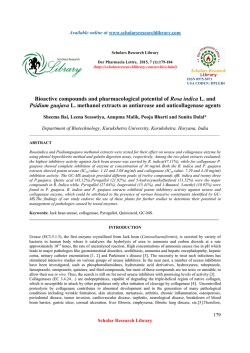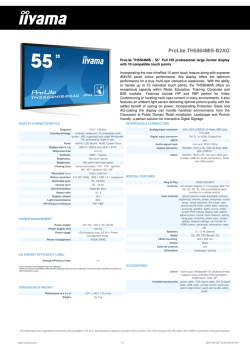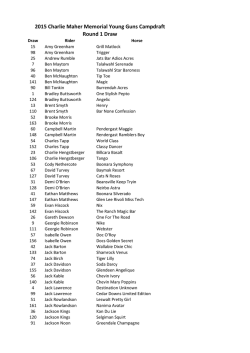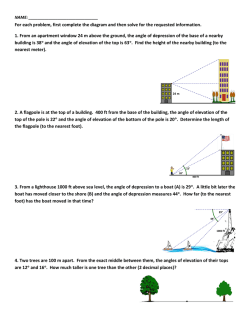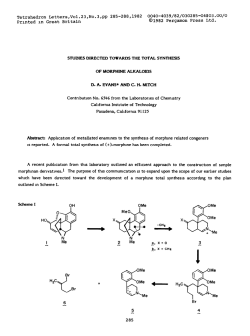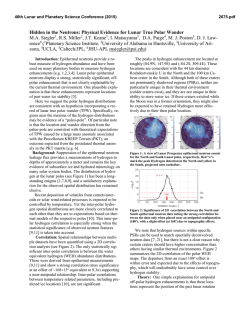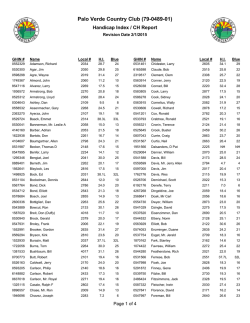
New class of urease inhibitors, molecular docking and inhibition assay
Available online www.jocpr.com Journal of Chemical and Pharmaceutical Research, 2015, 7(1):10-15 Research Article ISSN : 0975-7384 CODEN(USA) : JCPRC5 Gossypol: New class of urease inhibitors, molecular docking and inhibition assay Yixiong Chen1, Junjian Liao1, Min Chen2, Qiaoyi Huang3 and Qiming Lu1* 1 Institute of Biomaterial, South China Agricultural University, Guangzhou, China Center of Experimental Teaching for Common Basic Courses, South China Agricultural University, Guangzhou, China 3 Key Laboratory of Plant Nutrition and Fertilizer in South, China _____________________________________________________________________________________________ 2 ABSTRACT Molecular docking and urease inhibition assay were carried out to evaluate the inhibitory activities of (-)-gossypol, gossypolone and apogossypol on Jack bean urease. The binding free energies, action sites, inhibition constants and hydrogen bonds were predicted by molecular docking study. From the docking data, the binding free energies of the three compounds were -4.39 kcal/mol, -4.91 kcal/mol and -7.07 kcal/mol, respectively. And the estimated inhibition constant of the three compounds were 607.51, 251.73 and 6.57, respectively. In addition, the inhibition assay indicated that these compounds showed varying degree of urease inhibitory activity. From the experimental results, the half maximal inhibitory concentration of (-)-gossypol, gossypolone and apogossypol were 110 µM, 51.7 µM and 9.8 µM, correspondingly. On the basis of the docking and the experimental results, both of them indicated that the hydroxyl groups of (-)-gossypol, gossypolone and apogossypol played a key role in inhibiting Jack bean urease activity, especially 6,6′-OH and 7,7′-OH. Keywords: molecular docking; gossypol; gossypolone; apogossypol; Urease Inhibitor _____________________________________________________________________________________________ INTRODUCTION Urease (urea amidohydrolase, E.C. 3.5.1.5) is an enzyme and is widely distributed in a variety of bacteria such as Helicobacter pylori and Proteus mirabilis. It plays an important role in catalyzing hydrolysis of urea to carbonate and ammonia, which significantly decreases acidity of gastric juice. Therefore, urease has been considered as a main cause of peptic ulcers [1]. The catalytic property of urease has been widely studied in various field. In 1935, Rotini firstly proposed that there was urease existing in the soil [2]. After that, the work of Conrad [3] provided the convincing evidence to support Rotini. In agriculture, the excessive hydrolysis of urea with existence of soil urease causes plantlets nitrogen poisoning or alkali-induced damage. And the unproductive evaporation of urea caused by urease also leads to certain environmental pollution [4]. Therefore, it is important to understand the hydrolysis mechanism of urea, inhibiting urease activity, and lowing the negative influence derived from high hydrolysis of urea. To solve the problems, the urease inhibitors have been studied widely. Urease inhibitor can effectively inhibit the urease activity to reduce ammonia production. They are widely used in agriculture, animal husbandry and other fields. Until now, urease inhibitors studied have been broadly classified into three types: (1) organic compounds, such as 1,4-benzoquinone, humic acid, and acetohydroxamic acid [5–7]; (2) heavy metal ions, such as Cu2+, Ag2+, Hg2+, and Cd2+ [8, 9]; and metal-organic complexes [10-12]. However, the shortcoming of them has limited their wide application. Therefore, it is desired to develop a kind of natural, abundant, and cheap urease inhibitor. Gossypol, 2,2′-bis(8-formyl-1,6,7-trihydroxy-5-isopropyl-3-methylnaphalene) (see Figure 1), extracted from cotton 10 Qiming Lu et al J. Chem. Pharm. Res., 2015, 7(1):10-15 ______________________________________________________________________________ seeds has wide biological activities and is largely known as a prospective ingredient of acyeterion for man. It is pure natural and environment-friendly. Moreover, some of gossypol derivatives also display several potentially useful biological activities such as antifungal, anticancer and antiviral[13]. Based on these properties mentioned, we supposed that these compounds could be used as a new kind of urease inhibitors. So, we carried out theoretical and experimental investigations about inhibition of gossypol, gossypolone and apogossypol on Jack bean Urease. Figure1. Chemical structure of gossypol EXPERIMENTAL SECTION To verify our assumption, we firstly carried out a molecular docking study on the proposed molecules using Autodock program [14]. Automated docking is widely used for the prediction of biomolecular complexes in structure/function analysis and in molecular design. Using the program, we predicted the interaction between the compounds and urease so as to screen the compounds to conduct the experimental test. The conformations of gossypol and its two derivatives combined with Jack bean urease were simulated. The binding free energies, action sites, inhibition constants and hydrogen bonds were calculated. On the basis of these results, experimental study was performed avoiding the waste of manpower and material resources. In the experiments, (-)-gossypol ((-)-GOS), gossypolone (GN) and apogossypol (AG) were synthesized and used to perform the urease-inhibition assay. IC50 of the three compounds on Jack bean urease were obtained by monitoring the inhibitory effect of various concentrations of the compounds. Molecular docking Molecular docking simulations were performed using AutoDock program with Lamarckian genetic algorithm [15]. AutoDockTools (ADT) was used to build the geometry of Jack bean urease based on the X-ray structure (PDB ID: 3LA4, entry 3LA4 in the Protein Data Bank) [27, 28]: all H-O-H residues were removed, all hydrogens were added, Gasteiger charges were calculated and nonpolar hydrogens were merged. The initial parameters of Ni were set as q=+2.000, r=1.170Å, and van der Waals well depth of 0.100 kcal/mol. The 3D structures of Gossypol, gossypolone and apogossypol coming from the Pub chem. database were saved as pdb files which were then transformed to pdbqt files after the charges of the nonpolar hydrogen atoms were assigned with the aid of ADT [16]. In all docking, a grid box size of 60×60×60 pointing in x, y, and z dimensions was built, the maps were centered on the S atom (x=-39.313, y=-45.739, z= 82.076) in MET637 residue of Jack bean urease. A grid spacing based on the default setting was 0.375 Å. And the gpf file was generated to run AutoGrid for the calculation of the energetic map. After successful calculations, the docking parameter file (.dpf file) was prepared to run AutoDock. Default settings were used with an initial population size of 150 randomly placed individuals, a maximum number of 2.5×106(medium) energy evaluations, and a maximum number of 2.7×104 generations. A mutation rate of 0.02, a crossover rate of 0.8, and GA crossover mode of twopt were chosen. One hundred runs were generated by using Lamarckian genetic algorithm searches. On successful completion of docking the resultant complex structures were selected based on the most favorable free energy of binding. Synthesis According to the literatures reported, L-Trp-OMe-(-)-GOS (2), (-)-gossypol((-)-GOS) (3), gossypolone(GN) (4), and apogossypol(AG) (5) were synthesized[17,18] . The synthetic routes were shown in Figure 2. Urease inhibition assay In reaction vessel, reaction mixtures comprising 3 mL (9.129 units per mL) of enzyme (Jack Bean urease) solution and 10mL of distilled water were incubated with 1 mL of gossypol and its derivatives of various concentrations (dissolved in the solution of absolute ethanol) at 37 °C for one hour. After one hour, buffer solution (pH 7.0) and 1 mL 10% urea solution were added to each reaction vessel and the final volume was 50 mL. After 0.5 hours at 37 °C, The increased absorbance of 50 mL solution comprised of 2 mL filtrate, 4 mL sodium phenolate (1.35mol/L) and 3 mL sodium hypochlorite (15%) as chromogenic reagent was measured at 630 nm using UV-Vis spectrophotometer. Percentage inhibition (I) was calculated from the rate of decreased absorbance. 11 Qiming Lu et al J. Chem. Pharm. Res., 2015, 7(1):10-15 ______________________________________________________________________________ Figure 2. Synthetic route of Gossypol and its two derivatives The IC50 of gossypol and its two derivatives were determined by monitoring the inhibitory effect of various concentrations of these compounds in the assay. The value of IC50 was then calculated based on the Sigmoidal fitting equation according to relationship between various concentrations of the gossypol derivatives and their percentage inhibitions. RESULTS AND DISCUSSION The molecular docking results reveal that all the compounds studied in this work can interact with Jack bean urease. The geometries of docking complexes with the most favorable binding free energies were illustrated in Figure 3. The figure indicates that the hydroxyl groups of these compounds play a key role in the interactions. (a) (b) (c) (a) Gossypol is bound into Jack bean urease; (b) Gossypolone is bound into Jack bean urease; (c) Apogossypol is bound into Jack bean urease (entry 3LA4 in the Protein Data Bank). (Colored by atom: carbon—grey; oxygen—red; nitrogen—blue; Ni—green;Phosphorus—orange. The green lines show the hydrogen bond.) Figure 3. Gossypol and its derivatives are bound into Jack bean urease Gossypol interacts with urease with binding free energy of -4.39kcal/mol. As shown in Figure 4a, hydrogen atom of 7-OH in gossypol forms hydrogen bond with the oxygen atom of ASP587 (length of the hydrogen bond: 1.962Å; angle of the hydrogen bond: 153.73°). Another hydrogen bond is formed between the hydrogen atom of 6′-OH in gossypol and the oxygen atom of GLY638 (2.121Å; 124.843°). Simultaneously, oxygen atom of 6′-OH in gossypol forms hydrogen bond with the hydrogen atom of GLY638 (1.731Å; 174.746°). Moreover, the hydrogen atom of 7′-OH in gossypol forms a hydrogen bond with nitrogen atom of MET637 (1.535Å; 147.984°). Gossypolone interacts with urease with binding free energy of -4.91kcal/mol. As shown in Figure 4b, there are two hydrogen bonding interactions between gossypolone and urease. One of the two hydrogen bonds is formed by the oxygen atom of 6′-OH in gossypolone and the hydrogen atom of GLY638 (2.208Å; 146.857°). The other one is formed by the hydrogen atom of 7-OH in gossypolone and the oxygen atom of ASP587 (1.755Å; 143.128°). 12 Qiming Lu et al J. Chem. Pharm. Res., 2015, 7(1):10-15 ______________________________________________________________________________ Apogossypol interacts with urease with binding free energy of -7.07kcal/mol. As shown in Figure 4c, Hydrogen atom of 7-OH in apogossypol forms a hydrogen bond with the oxygen atom of GLU493 (2.14Å; 132.685°). Another hydrogen bond is formed between the oxygen atom of ARG439 and the hydrogen atom of 7′-OH in apogossypol (2.131Å; 150.813°). Simultaneously, hydrogen atom of ARG439 forms a hydrogen bond with the oxygen atom of 6′-OH in apogossypol (1.575Å; 159.031°) Furthermore, the hydrogen atom of 1-OH in agossypol forms a hydrogen bond with oxygen atom of [PO4]3-844 (1.834Å; 147.137°). From the above discussion, it is evident that the hydroxy groups are important in the interaction between the three compounds and Jack bean urease, especially 1,1′-OH, 6,6′-OH and 7,7′-OH of gossypol and its derivatives. To get a better comprehension of the conformations of Jack bean urease adducts formed by gossypol and its derivatives with the most favorable binding free energy, the other docking results including the electrostatic energy, the estimated inhibition constant, the final total internal energy, and vdW+Hbond+desolv energy are listed in Table 1. From the table, it is obvious that the apogossypol is the most effective inhibitor for the Jack bean urease in the three compounds. The surface models of the adducts are shown in Figure 4, which displays that the gossypol and its derivatives are filled in the active site of the urease. Table 1. Results of the molecular modeling study for gossypol and its two derivatives Compound EFEOB. EIC. H-bond Gossypol Gossypolone Apogossypol -4.39 -4.91 -7.07 607.51 251.73 6.57 √ √ √ vdW + Hbond + desolv Energy -6.9 -7.04 -8.51 Elect. FTIE. -0.51 -0.34 -1.03 -0.65 -1.87 1.16 EFEOB.(kcal/mol) is minimum energy in the estimated free energy of binding by compound with Jack bean Urease; EIC. is estimated inhibition constant in the minimum estimated free energy of binding by compound with Jack bean Urease; Elect.(kcal/mol) is electrostatic energy in the minimum estimated free energy of binding by compound with Jack bean Urease; FTIE.(kcal/mol) is final total internal energy in the estimated free energy of binding by compound with Jack bean Urease; “√” stands for that there were H-bonds between compound and Jack bean Urease. (a) (b) (c) (a) Binding mode of gossypol with Jack bean Urease. The urease is shown as Surface. The gossypol is shown as sticks; (b) Binding mode of apogossypol with Jack bean Urease. The urease is shown as Surface. The apogossypol is shown as sticks; (c) Binding mode of gossypolone with Jack bean Urease. The urease is shown as Surface. The gossypolone is shown as sticks. Figure 4. Binding mode of gossypol and its two derivatives with Jack bean Urease 60 (-)GOS 40 30 20 10 0 80 60 40 20 2 4 6 8 10 12 Concentration of inhibitor/(×10-5mol/L) 14 80 60 40 20 0 0 0 AG GN Percent inhibition/% Percent inhibition/% Percent inhibition/% 100 100 50 0 5 10 15 20 Concentration of inhibitor/(×10-5mol/L) 25 -1 0 1 2 3 4 5 6 7 8 Concentration of inhibitor/(×10-5mol/L) Figure 5. Percentage inhibition (I) of various concentrations of gossypol derivatives Based on the molecular docking results, gossypol and its two derivatives were synthesized for the inhibition assay. 13 Qiming Lu et al J. Chem. Pharm. Res., 2015, 7(1):10-15 ______________________________________________________________________________ The percentage inhibition of various concentrations of gossypol and its derivatives are shown in Figure 5. Each curve was made and analyzed using the sigmoidal curve-fitting methods[19]. The fitting equations, the square of correlation coefficient and the value of IC50 were listed in Table 2. Table 2. The value of each parameter in the sigmoidal curve fitting Compound (-)-gos The Fitting Equation y=96.06+(-5471.7296.06)/(1+exp((x+0.000636)/0.000156)) R 2 0.9716 -5 11 GN y=102.17+(-130292.380.9472 102.17)/(1+exp((x+0.000592)/0.0000823)) 5.17 AG y=87.92+(-1.24-87.92)/(1+exp((x0.00000919)/0.00000211)) 0.98 0.9339 -1 IC50/10 mol·L From these results, we could observe that each compound could inhibit the Jack bean urease. As the concentration of gossypol and its derivatives increasing, the percentage inhibition of them was improved. Gossypolone is the oxidation form of gossypol whose 1,1′-OH are oxidized. Apogossypol is another derivative of gossypol whose 8,8′-CHO are eliminated. According to the IC50 data, apogossypol was the most effective inhibitor for the Jack bean urease among the three compounds, which was accordance with the docking results. The experimental results showed that the elimination of the aldehyde group or the oxidation of 1,1′-OH of gossypol could increase the inhibitory effect. Besides, 1,1′-OH of apogossypol could form a hydrogen bond with Jack bean urease from the docking results. It was implied that in the inhibition process, 8,8′-CHO of naphthalene ring was not a key group while 1,1′-OH played a very important role. Based on the above comprehensive analysis combined with the molecular docking results, we suggested that the function groups in the naphthalene rings, especially 1,1′-OH, 6,6′-OH and 7,7′-OH, maybe played a key role in inhibiting Jack bean urease activity. CONCLUSION In this work, the urease inhibiting of gossypol, gossypolone and apogossypol was firstly investigated theoretically and experimentally. The molecular docking results reveal that these compounds are in close interaction with Jack bean Urease by the phenolic hydroxyl groups, which implies that gossypol, gossypolone and apogossypol had potential inhibitory effect to Jack bean urease. The urease inhibition assay indicates that these compounds can inhibit the Jack bean urease efficiently. Under the comprehensive analysis, the phenolic hydroxyl groups of 1,1′-OH, 6,6′-OH and 7,7′-OH were found to act as a key role in the inhibition activity and apossypol had the most inhibitory effect to the Jack bean urease in the three compounds. Acknowledgements This work was supported by National Science Foundation of China (31272241), Natural Science Foundation of Guangdong Province (s2012010010740) and Key Laboratory of Plant Nutrition and Fertilizer in South , Ministry of Agriculture, Guangdong Key Laboratory of Nutrient Cycling and Farmland Conservation (TFS2011-01) and Science and technology planning project of Guangdong Province(2012B020310003). REFERENCES [1] S Vassiliou; A Grabowiecka; P Kosikowska; A Yiotakis; P Kafarski; L Berlicki. Med. Chem. 2008,51,5736-5744. [2] OT Rotini. Ann. Labor. Ric. Fem. 1935,3;134-154. [3] JP Conrad. Soil Sci. 1940,50,119-134. [4] JM Bremner. Natr. Cycl. Agroecosys. 1995, 42,321-329. [5] Z Amtul; AU Rahman; RA Siddiqui; MI Choudhary. Curr. Med. Chem. 2002,9,1323-1348. [6] W Zaborska; M Kot; K Superata. J. Enzym. Inhib. Med. Chem. 2002,17,247-253. [7] MA Pearson; LO Michel; RP Hausinger; PA Karplus. Biochem. 1997,36,8164-8172. [8] W Zaborska; B Krajewska; Z Olech. J. Enzyme Inhib. Med. Chem. 2004,19,65-69. [9] WX Zaborska, B Krajewska, M Leszko; Z Olech. J. Mol. Catal. B: Enzym. 2011,13,103-108. [10] DH Shi; ZL You; C Xu; Q Zhang; HL Zhu. Inorg. Chem. Comm. 2007,10,404-406. 14 Qiming Lu et al J. Chem. Pharm. Res., 2015, 7(1):10-15 ______________________________________________________________________________ [11] ZL You; P Zhou. Transition Met. Chem. 2008,33,453-457. [12] K Cheng; QZ Zheng; HL Zhu. Inorg. Chem. Comm. 2009,12,1116-1119. [13] JAKenar. Reaction Chemistry of Gossypol and Its Derivatives. J. Am. Oil Chem. Soc. 2006,83 ,269-302. [14] GM Morris; R Huey; W Lindstrom; MF Sanner; RK Belew; DS Goodsell; AJ Olson. J. Comput. Chem. 2009, pp. 10-23. [15] MF Sanner; BS Duncan; CJ Carillo ; AJ Olson. Pac. Symp. Biocomput. 1999,4,401-402. [16] N Zhang; CY Huang; DH Shi ; ZL You. Inorg. Chem. Commun. 2011,14,1636-1639. [17] HX Jiang; XX Cao; H Huang ; B Jiang. Tetrahedron: Asymmetry, 2007,18,2437-2441. [18] L Zhang; HX Jiang; XX Cao ; HY Zhao ; F Wang ; YX Cui B Jiang. Eur. J. Med. Chem. 2009, 44, 3961-3972. [19] E Wittekindt; M Werner; A Reinicke; A Herbert; P Hansen. Environ. Technol. 1996,17,597-603. 15
© Copyright 2025
